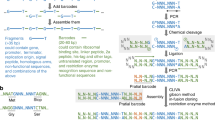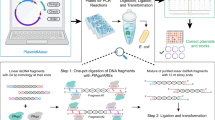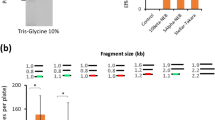Abstract
High-throughput genomics, proteomics and synthetic biology studies require ever more efficient and economical strategies to clone complex DNA libraries or variants of biological modules. In this paper, we provide a protocol for a sequence-independent approach for cloning complex individual or combinatorial DNA libraries, and routine or high-throughput cloning of single or multiple DNA fragments. The strategy, called circular polymerase extension cloning (CPEC), is based on polymerase overlap extension and is therefore free of restriction digestion, ligation or single-stranded homologous recombination. CPEC is highly efficient, accurate and user friendly. Once the inserts and the linear vector have been prepared, the CPEC reaction can be completed in 10 min to 3 h, depending on the complexity of the gene libraries.
This is a preview of subscription content, access via your institution
Access options
Subscribe to this journal
Receive 12 print issues and online access
$259.00 per year
only $21.58 per issue
Buy this article
- Purchase on Springer Link
- Instant access to full article PDF
Prices may be subject to local taxes which are calculated during checkout




Similar content being viewed by others
References
Quan, J. & Tian, J. Circular polymerase extension cloning of complex gene libraries and pathways. PLoS ONE 4, e6441 (2009).
Horton, R.M., Hunt, H.D., Ho, S.N., Pullen, J.K. & Pease, L.R. Engineering hybrid genes without the use of restriction enzymes: gene splicing by overlap extension. Gene 77, 61–68 (1989).
Prodromou, C. & Pearl, L.H. Recursive PCR: a novel technique for total gene synthesis. Protein Eng. 5, 827–829 (1992).
Stemmer, W.P., Crameri, A., Ha, K.D., Brennan, T.M. & Heyneker, H.L. Single-step assembly of a gene and entire plasmid from large numbers of oligodeoxyribonucleotides. Gene 164, 49–53 (1995).
Shevchuk, N.A. et al. Construction of long DNA molecules using long PCR-based fusion of several fragments simultaneously. Nucleic Acids. Res. 32, e19 (2004).
Smith, H.O., Hutchison, C.A. III, Pfannkoch, C. & Venter, J.C. Generating a synthetic genome by whole genome assembly: phiX174 bacteriophage from synthetic oligonucleotides. Proc. Natl. Acad. Sci. USA 100, 15440–15445 (2003).
Tian, J. et al. Accurate multiplex gene synthesis from programmable DNA microchips. Nature 432, 1050–1054 (2004).
Garces, C. & Laborda, J. Single-step, ligase-free cloning of polymerase chain reaction products into any restriction site of any DNA plasmid. Anal. Biochem. 230, 178–180 (1995).
McArthur, G.H.T. & Fong, S.S. Toward engineering synthetic microbial metabolism. J. Biomed. Biotechnol. 2010, ID459760 (2010).
Cohen, S.N., Chang, A.C., Boyer, H.W. & Helling, R.B. Construction of biologically functional bacterial plasmids in vitro. Proc. Natl. Acad. Sci. USA 70, 3240–3244 (1973).
Scharf, S.J., Horn, G.T. & Erlich, H.A. Direct cloning and sequence analysis of enzymatically amplified genomic sequences. Science 233, 1076–1078 (1986).
Walhout, A.J. et al. GATEWAY recombinational cloning: application to the cloning of large numbers of open reading frames or ORFeomes. Methods Enzymol. 328, 575–592 (2000).
Hartley, J.L., Temple, G.F. & Brasch, M.A. DNA cloning using in vitro site-specific recombination. Genome Res. 10, 1788–1795 (2000).
Aslanidis, C. & de Jong, P.J. Ligation-independent cloning of PCR products (LIC-PCR). Nucleic Acids. Res. 18, 6069–6074 (1990).
Li, M.Z. & Elledge, S.J. Harnessing homologous recombination in vitro to generate recombinant DNA via SLIC. Nat. Methods 4, 251–256 (2007).
Rashtchian, A. Novel methods for cloning and engineering genes using the polymerase chain reaction. Curr. Opin. Biotechnol. 6, 30–36 (1995).
Nisson, P.E., Rashtchian, A. & Watkins, P.C. Rapid and efficient cloning of Alu-PCR products using uracil DNA glycosylase. PCR Methods Appl. 1, 120–123 (1991).
Gibson, D.G. et al. One-step assembly in yeast of 25 overlapping DNA fragments to form a complete synthetic Mycoplasma genitalium genome. Proc. Natl. Acad. Sci. USA 105, 20404–20409 (2008).
Shao, Z., Zhao, H. & Zhao, H. DNA assembler, an in vivo genetic method for rapid construction of biochemical pathways. Nucleic Acids. Res. 37, e16 (2009).
Sambrook, J. & Russell, D.W. Molecular Cloning: A Laboratory Manual 3rd edn. (Cold Spring Harbor Laboratory Press, Cold Spring Harbor, N.Y., 2001).
Breslauer, K.J., Frank, R., Blocker, H. & Marky, L.A. Predicting DNA duplex stability from the base sequence. Proc. Natl. Acad. Sci. USA 83, 3746–3750 (1986).
Acknowledgements
We thank Z. Chen and P. Zuo for technical assistance. J.T. is a Beckman Young Investigator and a recipient of a Hartwell Individual Biomedical Research Award.
Author information
Authors and Affiliations
Contributions
J.T. conceived the CPEC strategies and supervised the project. J.Q. performed the experiments. Both authors contributed extensively to the experimental design, protocol development and manuscript preparation.
Corresponding author
Ethics declarations
Competing interests
The authors declare no competing financial interests.
Supplementary information
Supplementary Table 1
PCR templates and primers used in the anticipated result examples. (DOC 28 kb)
Supplementary Table 2
Primer sequences used in the Anticipated Result Section. (DOC 31 kb)
Supplementary Figure 1
CPEC cloning of 14 gene libraries in parallel. The upper bands (red arrow) are the full-length cloning products whereas the lower bands (blue arrow) are the unincorporated vectors. Five thermal cycles were performed in CPEC. (DOC 361 kb)
Rights and permissions
About this article
Cite this article
Quan, J., Tian, J. Circular polymerase extension cloning for high-throughput cloning of complex and combinatorial DNA libraries. Nat Protoc 6, 242–251 (2011). https://doi.org/10.1038/nprot.2010.181
Published:
Issue Date:
DOI: https://doi.org/10.1038/nprot.2010.181
This article is cited by
-
Single-domain antibodies against SARS-CoV-2 RBD from a two-stage phage screening of universal and focused synthetic libraries
BMC Infectious Diseases (2024)
-
Red Fluorescent Protein Variant with a Dual-Peak Emission of Fluorescence
Marine Biotechnology (2023)
-
Expanding luciferase reporter systems for cell-free protein expression
Scientific Reports (2022)
-
Microfluidic deep mutational scanning of the human executioner caspases reveals differences in structure and regulation
Cell Death Discovery (2022)
-
Fine-tuning the expression of pathway gene in yeast using a regulatory library formed by fusing a synthetic minimal promoter with different Kozak variants
Microbial Cell Factories (2021)
Comments
By submitting a comment you agree to abide by our Terms and Community Guidelines. If you find something abusive or that does not comply with our terms or guidelines please flag it as inappropriate.



